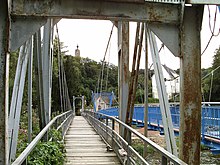Rochsburg
Rochsburg is a district of Lunzenau in the district of central Saxony . It has around 500 residents.
Geographical location
The village is located in the valley of the Zwickauer Mulde , about 20 km northwest of Chemnitz . The Rochsburg Castle of the same name rises on a mountain spur above the river . The place has an area of 3 km² and is 212 m above sea level. NN .
To the south and east of the village, on the slopes opposite the Mulde, there is the nature reserve " Um die Rochsburg ".
history
The eponymous Rochsburg originally belonged to the Gau Rochlitz, at whose feet the village probably later developed. In the period from 1190 to 1235 a Guntherus de Rohsberg is mentioned.
The late Romanesque village church (around 1180) was first mentioned in a document in 1195. In it is the free grave of the knight Wolf von Schönburg and his wife, which stylistically resembles that of Moritz von Sachsen in Freiberg Cathedral. In addition, there is a crypt (hereditary burial) of those of Schönburg in the village church .
tourism
At Rochsburg, pedestrians can cross the Zwickauer Mulde on a suspension bridge, which was replaced in 2011.
Rochsburg has a long tradition of recreation for the blind. Since 1953 there was a small sanatorium in a former factory owner's villa, which offered prophylactic cures especially for blind people with multiple disabilities . After German reunification , the Saxon Association of the Blind ( BSVS ) took over the Art Nouveau villa . At the turn of the millennium, it was extensively renovated under monument protection aspects with significant funding from the Free State of Saxony , and since the end of 2001 it has been the "Villa Rochsburg" inviting visitors to take part in recreational and educational stays. In the immediate vicinity is the first Saxon residential care home for the blind, visually impaired and sighted, which opened in 1999.
The castle
Rochsburg Castle, presumably founded in the late 12th century, stands on a rocky spur surrounded by the Zwickauer Mulde on three sides above the village of Rochsburg. Although a "Gunteros de Rochsberg" has been mentioned several times since the 1190s, it is not certain whether the castle was built before 1200. It is a landmark of the district that can be seen from afar . The entire medieval complex can still be seen clearly. In its current appearance, however, the castle dates from the late Gothic and Renaissance periods . Its main construction phases date from 1470 and from 1548; it is an important example of Renaissance architecture in Saxony.
For centuries the Rochsburg was the eponymous center of the Saxon office of Rochsburg. The Rochsburg remained in the possession of the noble family of the Counts and Lords of Schönburg from 1548 to 1945 . In 1945 the aristocratic family was expropriated as part of the land reform and the complex came to the state of Saxony. In 1952, the then Rochlitz district took over Rochsburg. After this opened up in the Mittweida district in 1994 , Mittweida continued to use it, and since 2008 the district of central Saxony . The museum in the castle has been operated by the Mittelächsische Kultur gGmbH since 2009 and invites you to experience the 800-year history of the facility. Historical furniture, furnishings and paintings from the 16th to 19th centuries are exhibited in five representative rooms, including the ancestral gallery of the Counts of Schönburg .
traffic
The Rochsburg train station , which opened on May 29, 1876, was located on a rock face; the only way to build the station was by building a long retaining wall. The station therefore only had three tracks, one was used for freight traffic, while the other two were platform tracks. In addition to the goods shed, a comparatively large entrance building was also built. On November 7, 1968, freight traffic was stopped and the station was downgraded to a stop. With the closure of the Glauchau – Wechselburg section on August 13, 2002, the Rochsburg stop went out of service. Rochsburg Castle is within sight .
The 285 m long railway tunnel was created when the Muldental Railway was built between 1872 and 1876. The breakthrough took place on November 13, 1874. According to the Colditzer Wochenblatt of December 3, 1874, the difference when the holes met was only 1 millimeter.
Personalities
- Georg Theodor Hoffmann (1848–1919), Reich judge born in Rochsburg
- Hans Zesewitz (1888–1976), archivist and Karl May researcher, worked as a teacher in Rochsburg from 1909 to 1912
- Paul Keller (1895–1969), politician
literature
- Richard Steche : Rochsburg. In: Descriptive representation of the older architectural and art monuments of the Kingdom of Saxony. 14th booklet: Amtshauptmannschaft Rochlitz . CC Meinhold, Dresden 1890, p. 78.
- Helmuth Gröger: The Rochsburg . In: Burgen und Schlösser in Sachsen , Heimatwerk Sachsen, 1940, pp. 72–73
- Robby Joachim Götze: On the funeral of Count August Ernst von Schönburg in 1729 , In: Series of publications Heft 12, Museum and Art Collection Schloss Hinterglauchau, Glauchau, 2008, pp. 19–30 (The traditional funeral ceremony of Count August Ernst von Schönburg (1666–1729) in the village of Rochsburg and in the Rochsburg village church and its crypt in 1729)
Web links
Individual evidence
- ↑ Ernst Eichler , Hans Walther (ed.): Historical book of place names of Saxony. Berlin 2001, ISBN 3-05-003728-8 , Volume II, pp. 291f.
- ^ Georg Dehio : Handbook of German Art Monuments, Saxony II, administrative districts of Leipzig and Chemnitz. Munich 1998, ISBN 3-422-03048-4 , pp. 661f.
- ^ Steffen Kluttig: Railway history in the Muldenland - the Rochlitz railway junction and its sand railways. P. 62.
Coordinates: 50 ° 57 ' N , 12 ° 46' E







